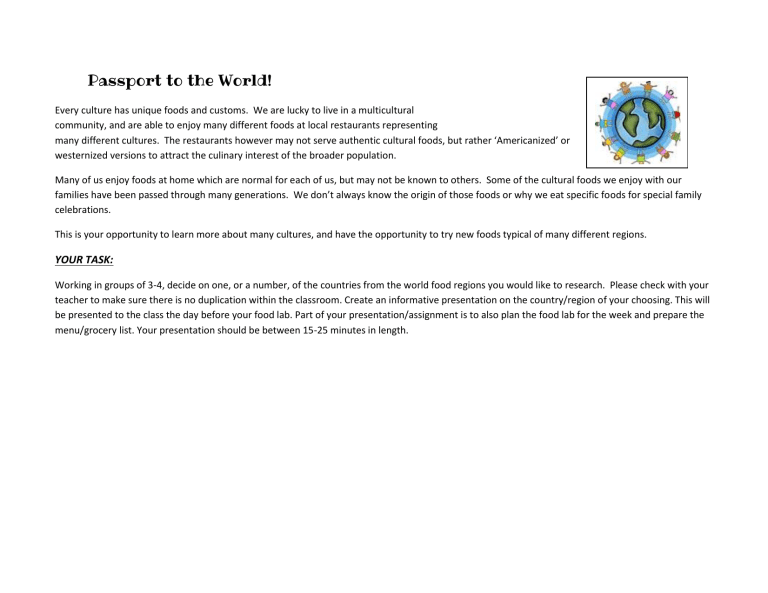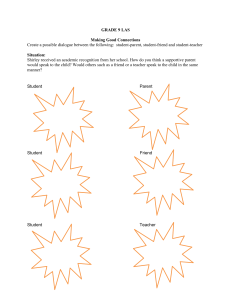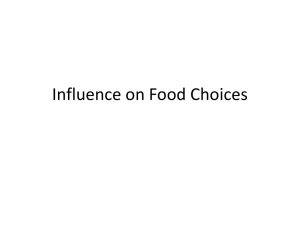
Passport to the World! Every culture has unique foods and customs. We are lucky to live in a multicultural community, and are able to enjoy many different foods at local restaurants representing many different cultures. The restaurants however may not serve authentic cultural foods, but rather ‘Americanized’ or westernized versions to attract the culinary interest of the broader population. Many of us enjoy foods at home which are normal for each of us, but may not be known to others. Some of the cultural foods we enjoy with our families have been passed through many generations. We don’t always know the origin of those foods or why we eat specific foods for special family celebrations. This is your opportunity to learn more about many cultures, and have the opportunity to try new foods typical of many different regions. YOUR TASK: Working in groups of 3-4, decide on one, or a number, of the countries from the world food regions you would like to research. Please check with your teacher to make sure there is no duplication within the classroom. Create an informative presentation on the country/region of your choosing. This will be presented to the class the day before your food lab. Part of your presentation/assignment is to also plan the food lab for the week and prepare the menu/grocery list. Your presentation should be between 15-25 minutes in length. STEP 1: The Groups Sign up for the region that you are interested in researching the foods and flavours of and want to be part of preparing the menu for the food lab. Group # Region 1 2 3 4 5 6 South Europe- Greece Group Member Group Member Group Member North America- Mexico South Asia- Pakistan East Asia- China South America- Bolivia North Africa- Egypt STEP 2: Choose one World Cuisine: Africa – North – Algeria, Egypt, Libya, Morocco, Tunisia, Sudan South – Botswana, Madagascar, Mauritius, Namibian, South Africa, Zimbabwe East – Burundi, Eritrea, Ethiopia, Kenya, Somali, Tanzania, Uganda West – Burkina, Ghana, Ivory Coast, Nigeria, Sierra Leon, Senegal Central – Cameroon, Congo, Central African Republic Americas – North- Mexico Group Member Central – Belize, Costa Rica, Salvador, Guatemala, Honduras, Nicaragua, Panama South – Argentina, Bolivia, Brazil, Chile, Colombia, Cuba, Dominican Republic, Ecuador, Grenada, Guyana, Jamaica, Paraguay, Peru, Puerto Rico, Trinidad and Tobago, Uruguay, Venezuela Asia – Central – Bukharan, Kazakhstan, Kyrgyzstan, Tajikistan, Turkmenistan, Uzbekistan East – China, Japan, Hong Kong, Korea, Mongolia, Taiwan Southeast – Brunei, Burmese, Cambodia, Singapore, Malaysia, Indonesia, Laos, Filipino, Thailand, Vietnam West – Arab, Syria, Bahrain, Emirates, Iran, Iraq, Kuwait, Turkey, Yemen, Israel, Jordan, Lebanon South – Afghanistan, Bangladesh, Bhutan, India, Maldives, Nepal, Pakistan, Sri Lanka Europe – North – Estonia, Latvia, Lithuania, Denmark, Finland, Norway, Iceland, Greenland, Lapland South – Albania, Bosnia, Croatia, Greece, Kosovo, Macedonia, Montenegro, Turkey East – Belarus, Kazakh, Russian, Ukraine, Armenia, Georgia Central – Austria, Bulgaria, Czech, Germany, Hungary, Moldova, Polish, Romania, Serbia, Slovenia STEP 3: Sign up for presentation/lab week Dates: Region: Food: Group Members: April 20th/21st South EuropeGreece Moussaka May 4th/5th North AmericaMexico Quesadillas May 18th/19th South AsiaPakistan Samosas May 25th/26th East Asia- China Chow Mein June 1st/2nd South AmericaBolivia Alfajores The Tasks Topic Inquiry Question Task Requirements Geographical Impact Food Guidelines Westernized/ ‘Americanized’ Local How do the What are the What are the How do we better How do the How do the food geographical significant flavours, major factors that understand the holidays and guidelines of this factors affect the herbs, spices and influence food people of this traditions of this region reflect food production foods that security and region through region influence their cultures? and accessibility in influence this availability in this their food habits? the food culture of this culture's culture’s cuisine? region? this region? cuisine? What are Westernized versions of the foods available in grocery or restaurants? ❏ ❏ Flavours & Foods Research the ❏ location, terrain/landfor m and climate of your region Where is your country located ❏ geographically? Show a picture of the country on a map and show its relation to other countries. ❏ ❏ Research how the location affects the types of foods grown or available? What is the ❏ Food Security Research the ❏ flavours, staple foods, unique cooking techniques of ❏ that culture Create a table or graphic organizer which illustrates unique flavours, staple foods and cooking techniques, and how the recipes fit in to those ❏ categories (agriculture/cro ps/ staples) unique to the country Develop a 3 Research climate, agriculture, and food availability Research poverty statistics, food security programs available (food banks) and analyze food distribution through your country Based on your research, develop 2-3 slides as a response to this inquiry question Food Habits ❏ ❏ ❏ ❏ Research the eating patterns, manners, serving, dining etiquette, food preparation roles, social status and meals, and food waste found in this region Based on your research, develop a response to the inquiry question Use images to create the table environment or place settings for the food lab Curate a Holidays & Traditions ❏ ❏ ❏ ❏ Research how food is related to the holidays, celebrations, traditions, and religion of the region. How are the foods related to agriculture, staple foods, herbs and spices of the region? Based on your research, develop a response to the inquiry question As a group, develop a tourist style advertisement ❏ ❏ ❏ ❏ Research food guidelines from the region. How do food guides compare with Canada’s Guidelines to Healthy Eating? Based on your research, develop a response to the inquiry question. As a group, use images to compare food guidelines from Canada ❏ ❏ ❏ Research local restaurants representativ e of the region. How do menu items compare to menu items typical of the region; compare using websites like TripAdvisor, researching restaurants in the region you are researching. Consider menu items for breakfast, dinner, and ❏ ❏ terrain like in your country? How does this affect what is grown in this region? (Examples: mountainous, ❏ rocky, hilly, flat, valleys) What is the climate like in ❏ your country? Note that geography, ❏ climate and terrain for a region are all interrelated. How does climate affect the types of foods grown or available? course menu (appetizer, main dish, side dish, and dessert) that responds to the inquiry question Select recipes that fit the time constraints of the class Change the yield of the recipe to serve 4 people As a group, prepare a grocery order for all items needed for the lab; organize according to departments in a grocery store (produce, meats, dairy, canned goods) collection of images accompanied by descriptions which support your response about food habits about the food culture of the region with specific reference to holidays and traditions and add it to your slides Every week/every other week, we will prepare the recipes in class to represent the culture of the region selected. to the region with specific reference to written suggestions on Canada’s guidelines. ❏ desserts. Based on your research, develop a response to the inquiry question by including pictures from flyers in your slides Passport to the World – Summary Sheets! Country: _________________________ Food & Flavours What are significant foods/flavours/ herbs/spices used in the culture? How do recipes selected connect to the agriculture of the country? How do cooking techniquest connect to the culture of the country? Food Security Factors Influencing Food Security and Availability in Region (poverty statistics?) Community Support Programs available (food banks) Equal access/distribution of food issues throughout the country? Food Habits Typical Breakfast, Lunch, Dinner options Breakfast: Lunch: Dinner: Typical style of serving of meals and table settings Etiquette related to meals Meal preparation roles Food Waste Holidays & Traditions Specific food for holidays, celebrations, traditions or religious events ● ● ● How do holiday/traditional foods reflect agriculture and staples? Food Guidelines Unique layout or design of food guidelines 2 Key differences comparing to Canada’s Food Guide ● ● ● Westernized/Creolized Menus 2 Similar menu items compared to a restaurant in Canada ● ● 2 Different menu items compared to a restaurant in Canada ● ● Price Comparison – with currency conversion to compare same dollar values Passport to the World – Google Slides Template Cultural Foods Presentation Slide Order & Example Passport to the World- Evaluation Rubric HFC3C0 Identification of Traditional Food Recipes for Lab – 11 marks KU Appetizers, Main Course, Side Dish Dessert Graphic Organizer/Chart illustrating connection of recipes to flavours, staples and techniques Total KU Food Lab Preparation – 7 marks TI Effective, organized shopping list provided for food lab Evidence of proofreading Total TI Communication – 7 marks CO Professionalism – includes introduction Creativity and effort is evident in food habits images & descriptions Eye contact, voice level Evidence of proofreading Total CO 0 1 2 3 4 5 0 1 2 3 4 5 6 /11 0 1 2 3 4 5 0 1 2 /7 0 0 0 0 1 2 1 2 1 2 1 /7

